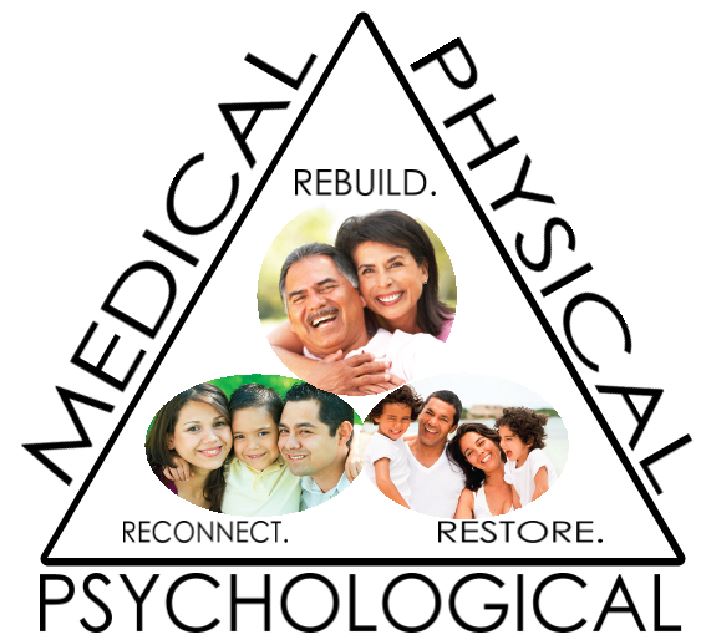Chronic Pain Medical Treatment Guidelines MTUS – 8 C.C.R. § 9792.24.2
In 1977, Engel proposed an alternative, the biopsychosocial model, which focuses greater attention on the patient, rather than presumed pathophysiology. The biopsychosocial model approaches pain and disability as a complex interplay of biological, psychological, and social factors. These psychosocial factors can be easily assessed.
Researchers have found evidence that psychosocial variables are strongly linked to the transition from acute to chronic pain disability and that psychosocial variables generally have more impact than biomedical or biomechanical factors on back pain disability. (Linton, 2000) Thus, when clinical progress is insufficient or protracted, the clinician should consider the possibility of delayed recovery and be prepared to address any confounding psychosocial variables.
|
BIOMEDICAL MODEL |
BIOPSYCHOSOCIAL MODEL |
|
|
|
|
|
|
|
|
|
|
The Northern California Functional Restoration Program is a comprehensive, inter-disciplinary program intended primarily to correct disability in patients with various diagnoses with demonstrated barriers to recovery including but not limited to de-conditioning, de-motivation, psychological dysfunction, lack of knowledge regarding disease processes, and inadequate tools to regain health and functionality. Our interdisciplinary approach integrates physical therapy, occupational therapy, mind-body medicine, counseling, and education, with vocational rehabilitation or return to work as a goal.
As outlined in the MTUS/Chronic Pain Medical Treatment Guidelines, page 31, there is no one universal definition of what comprises interdisciplinary/multidisciplinary treatment. The most commonly referenced programs have been defined in the following general ways (Stanos, 2006):
(1) Multidisciplinary programs: Involves one or two specialists directing the services of a number of team members, with these specialists often having independent goals.
(2) Interdisciplinary pain programs: Involves a team approach that is outcome focused and coordinated and offers goal-oriented interdisciplinary services. Communication on a minimum of a weekly basis is emphasized. The most intensive of these programs is referred to as a Functional Restoration Program, with a major emphasis on maximizing function versus minimizing pain.
Components suggested for interdisciplinary care include the following services delivered in an integrated fashion:
(a) Physical Treatment; (b) Medical Care and Supervision; (c) Psychological and Behavioral Care; (d) Psychosocial Care; (e)Vocational Rehabilitation and Training; and (f) Education.
There is a reported 50% return to work statistic in chronic pain patients attending an integrated functional restoration program. Patients who have failed multiple therapies, have changed physicians in search of an answer, who continually receive higher and higher amounts or narcotic medications, have lost hope, are depressed, angry and isolated are considered prime candidates for an interdisciplinary program.
“Intensive multidisciplinary rehabilitation with functional restoration is more effective in improving pain and function than outpatient non-multidisciplinary rehabilitation. At 4-month follow-up the median scores in the experimental group were 5.7/10 for pain and 12.1/30 for disability versus 6.9/10 and 16.8/30 in the untreated control group. More impressive was the difference in median number of sick leave days: 10 in the treatment group versus 122 in the no-treatment group.”
In the study above, even though the median scores on pain and disability were only minimally different, the scores indicate the treated patients are better able to live and work with their pain! A Goal of the Northern California Functional Restoration Program.
- Functional Restoration is a powerful multi-modality treatment consistent with the Chronic Pain Medical Treatment Guidelines (MTUS), which aims to improve the quality of life of chronic pain sufferers
- Research has shown that Functional Restoration Programs can effectively reduce the impact of pain in one’s life as well as restore function
- The principles of functional restoration apply to all conditions in general, and are not limited to injuries or pain
- To date, over 100 studies have been published in the medical literature characterizing the unique benefits of Multi-disciplinary Pain Rehabilitation.
- ACOEM Guidelines, MTUS, ODG
- Treated patients functioning better than 75% of controls
- Benefits persisted over time
- Improved return to work rates (RTWR)
- Decreased use of Health Care
Utilizing a multi-disciplinary approach, patients will learn new skills and coping tools to develop a realistic picture of what their life could be with a focus on mind-body wellness and integration, the foundation of the rebuilding process.

